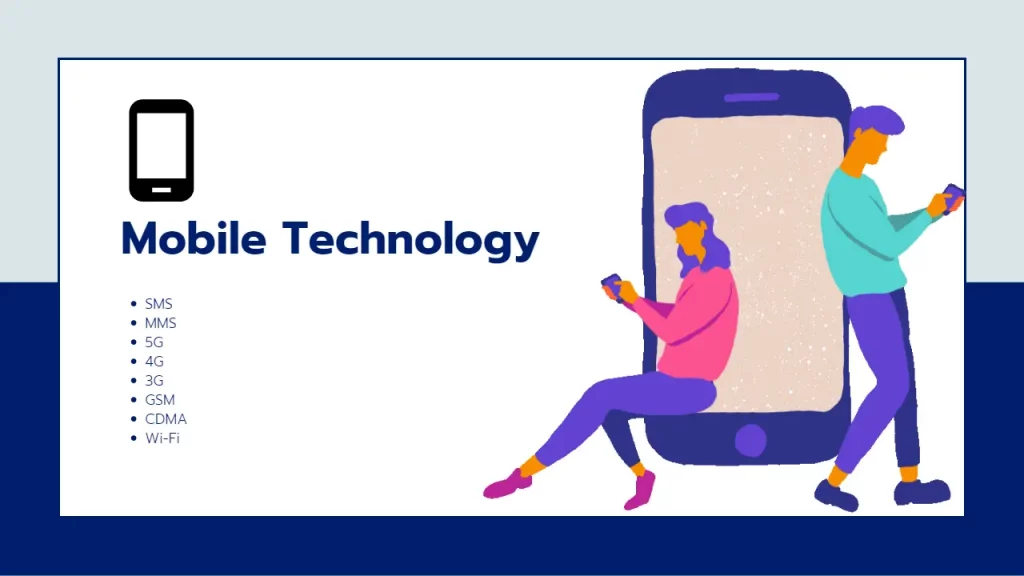Mobile technologies have come a long way in the last few decades. From the early days of 2G and limited texting capabilities, we now have access to high-speed internet and multimedia messaging on our mobile devices.
Mobile technology is the use of mobile phones and other portable computing devices to access the internet, send and receive data, and communicate with others. It includes the use of smartphones, tablets, and other portable technology to access the internet, connect with contacts, share data, and even make payments.
Mobile technology enables the user to send instant messages, make VoIP calls, view websites and videos, and interact with others through a variety of apps and platforms. Additionally, mobile technology has enabled businesses to create their own mobile applications to better serve their customers.

The technology is becoming more and more popular, with tablets and small PCs leading the way. The modern smartphone is no longer just a simple device used to make calls. The system has been upgraded and now functions as a powerful multitasking computer.
With a single smartphone, users can access navigation services such as GPS, play games, browse the internet, and send and receive instant messages. This eliminates the need to carry multiple gadgets or switch between different applications, making it easier to stay connected and entertained.
Portable laptops and tablets have made it easier for people to adopt mobile technology. These devices are connected through wireless networks, which allow users to share speech, data, and apps between mobile devices.
In this article, we will explore the different types of mobile technologies and how they have evolved over the years.
Table of Contents
SMS
SMS (Short Message Service) is one of the earliest forms of mobile technology, which allowed users to send short text messages to each other.
This technology was initially limited to 160 characters per message. With the introduction of new technologies and upgrades, the character limit has increased to over 700 characters, but the concept remains the same.
SMS remains a popular form of communication even today, especially for sending quick messages that do not require a response.
MMS
MMS, which stands for Multimedia Messaging Service, is an extension of Short Message Service (SMS) that allows users to send more than just text messages.
With MMS, users can now send multimedia content such as images, videos, and audio files. This has enabled users to communicate with each other in a more interactive and engaging way than what was previously possible with text messaging alone.
5G
5G mobile technology is the next generation of mobile communications technology that promises faster speeds, lower latency, and more reliable connections. 5G will enable faster data transmission, improved coverage, and higher capacity, allowing for more devices to be connected at the same time.
5G technology will also allow for more efficient use of spectrum, meaning more data can be transmitted within the same spectrum. 5G will be an important part of the future of mobile technology, allowing for more efficient communication and better user experience.
5G technology is expected to be available to consumers in the near future, and it will revolutionize the way we use mobile devices.
4G
4G (Fourth Generation) is a mobile technology that provides high-speed internet and multimedia capabilities to mobile devices. This technology was introduced in 2009 and has since become the standard for mobile networks around the world.
4G allows users to browse the internet, stream videos, play online games, and make video calls with much faster speeds and lower latency compared to previous generations of mobile technology. The widespread availability of 4G networks has had a significant impact on the way we use our mobile devices, making them essential tools for work and entertainment.
3G
3G (Third Generation) is a mobile technology that provided improved data capabilities compared to its predecessor, 2G. 3G allowed users to access the internet and send multimedia messages with faster speeds and better quality than before.
Although 3G was a significant improvement over 2G, it was soon surpassed by 4G in terms of speed and capabilities. Today, 3G networks are still available in some regions, but their usage has significantly declined with the widespread availability of 4G and 5G..
GSM
GSM (Global System for Mobile Communications) is the leading digital mobile technology used by more than 80% of mobile networks globally. It was first implemented in Finland back in 1991, and has since become the go-to standard for mobile communication.
GSM uses a combination of Frequency Division Multiple Access (FDMA) and Time Division Multiple Access (TDMA) to operate on four different frequency ranges: 850 MHz, 900 MHz, 1800 MHz, and 1900 MHz.
GSM provides users with a range of capabilities, including voice calls, text messaging, and data services. The widespread use of GSM technology has made it easier for people to communicate with each other, regardless of their location.
GSM technology is also used for mobile banking, mobile payments, and mobile commerce. It is also used for tracking and monitoring devices, such as GPS-enabled phones. GSM is also used for remote access to corporate networks, allowing employees to access their work from anywhere.
CDMA
CDMA (Code Division Multiple Access) is a type of cellular technology used in mobile phones. It is a digital technology that uses spread spectrum technology and a special coding scheme to allow multiple users to access a single radio frequency channel.
CDMA is a type of multiple access technology that allows multiple users to access a single radio frequency channel. It works by assigning each user a unique code, which is used to spread the user’s signal over the available frequency spectrum. This allows multiple users to share the same frequency channel without interference from other users.
CDMA is used in many cellular networks, including Verizon and Sprint in the United States. It is also used in many other countries around the world. CDMA is a reliable and efficient way to provide wireless communication services.
Although CDMA has been used by some mobile networks, it has not gained the same level of popularity as GSM and is gradually being phased out in favor of newer technologies.
Wi-Fi
Wi-Fi is a wireless technology that allows devices to connect to the internet without the need for cables. Wi-Fi networks are widely available in public places, such as airports, cafes, and hotels, allowing users to connect to the internet wherever they go.
The widespread availability of Wi-Fi networks has had a significant impact on the way we use our mobile devices, making it easier for us to stay connected and access the information we need, whether we are at home, at work, or on the go.
In conclusion, mobile technologies have come a long way since their inception, with each new generation offering improved capabilities and a better user experience. From the early days of SMS and limited data capabilities, we now have access to high-speed internet and multimedia messaging on our mobile devices. The widespread availability of mobile technologies has revolutionized the way we communicate and access information, making our lives easier and more connected. As technology continues to evolve, it will be interesting to see what new innovations are introduced and how they change the way we use our mobile devices in the future.




